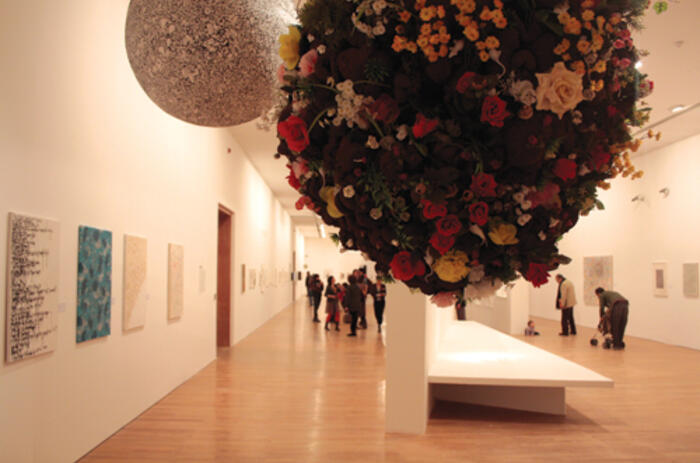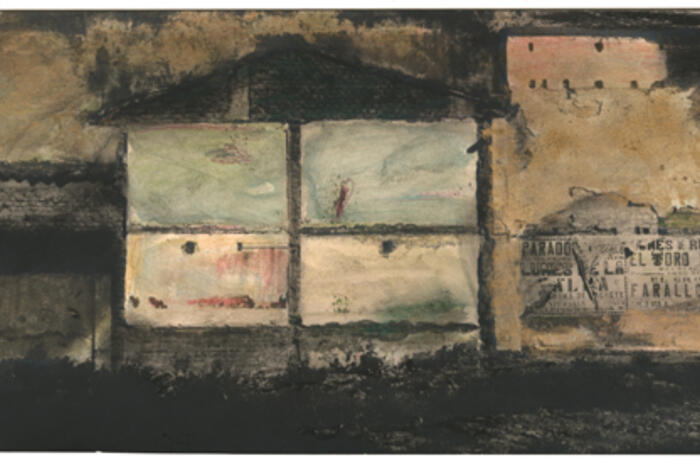Reviews

Carlos Cruz-Diez
Together with Jesús Rafael Soto and Alejandro Otero, Carlos Cruz- Diez is considered one of the precursors of the Kinetic Movement that developed in Paris between the 50s and the 60s,

León Ferrari
The Museo de Arte del Banco de la República is presenting a retrospective exhibition of the work of León Ferrari.

Fernell Franco
Photography in Colombia began to receive recognition only when Fernell Franco (1942-2006) obtained the top prize in his category at the 26th National Salon of Visual Arts in 1976, with his photo Interior.

Rosario Bond
Rosario Rivera-Bond (Santo Domingo, 1952) studied at L‘Académie de la Grande Chaumière, Paris, France and at the Camden Art Center, London, England (1975-79), during which period she also studied and lived in Paris, Florence, London and New York.

Graciela Iturbide
From April 2 to June 19, the Museum of Modern Art is presenting what has been considered Graciela Iturbide’s first retrospective show in Mexico, under the fine curatorship of Marta Dahó and sponsored by MAPFRE Foundation.

Andrés Michelena
In Content, Andrés Michelena’s exhibition at Hardcore Contemporary Space, the emptiness that prevails in the space makes slowness and contemplative silence a requisite for the tour of the show.
Graciela Sacco
A new solo show by Graciela Sacco was presented at Diana Lowenstein Fine Arts.

Ernesto Oroza
As part of the Contemporary Art Project (CAP) program, the Vizcaya Museum presented “Archetype Vizcaya”, an exhibition by Cuban-American artist Ernesto Oroza.

FLEA Ensemble
SUBTROPICS XXI, the latest edition of the Experimental Biennial of Music and Sound Art, which has been organized since its inception by the sound artist Gustavo Matamoros.

Inside Out, Photography after Form: Selections from the Ella Fontanals-Cisneros Collection
This International photography exhibit based on the Ella Fontanals-Cisneros Collection was featured as part of the exhibitions program revolving around Art Basel Miami 2010.

Resurfaced: Contemporary Colombian Art
Jaime Ávila, Barbarita Cardozo, Nicolás Consuegra, Miler Lagos, and the artist duo Magle compose the group of artists who participate in the exhibition “Resurfaced: Colombian Art”.

Hugo Bastidas
From March 15 to April 23 Nohra Haime gallery staged the exhibition “Fin de siècle” , a solo show by Hugo Bastidas, an artist born in Quito.

Prolonged Engagement
The exhibition “Prolonged Engagement”, a group show that gathered together artists who create aesthetic conditions rather than isolated art objects, takes its name from the traditional models of ethnography.

Iván Navarro
Heaven or Las Vegas is a spectacularly striking exhibition at the Paul Kasmin Gallery where ten wall and two floor sculptures occupy the three galleries.

Wilfredo Prieto
Wilfredo Prieto (Sancti-Spíritus, Cuba, 1978) is a name not unrelated to the reality of the most select circuits of today’s artistic map. Indeed, if pressed, I would say, and it would not be a novelty, that he is one of the most promising figures of contemporary Latin American art.
Anna María Maiolino
To talk about Anna María Maiolino (Scalea, Italy, 1942) is to talk about one of the essential voices and languages in Brazilian contemporary art, a necessary element to understand the evolution of artistic experimentation of the productive 1960s and fundamental to understand its later development.

Roberto Jacoby
Among the latest challenges posed by the RSNAM directors is “El deseo nace del derrumbe” (“Desire is born from collapse”), an interesting proposal which materializes the ambitious attempt of the Madrid museum, by way of a retrospective exhibition, to classify, agglutinate and interpret the work of multidisciplinary sociologist and artist Roberto Jacoby.

Eduardo Kac
Bio-art is one of the most recent trends developed by contemporary art, and its particularity is that it adopts biotechnology as a medium.

Alfredo Jaar
For many years now, even before political art had become fashionable, Alfredo Jaar (1956, Santiago,Chile) has been investigating the nature of images and the place the African Continent occupies in the world.

Marcos López
“Tierra en Trance” is the suggestive and evocative title of the first retrospective in France of the Argentine artist Marcos López (Santa Fe, 1958). The exhibition makes reference to a famous film by Glauber Rocha, a master of Brazilian “cinema novo”, which combines political themes with mythical and folkloric elements

Allora & Calzadilla
In the course of their joint artistic career, Jennifer Allora & Guillermo Calzadilla have developed a solid and versatile body of work based on a permanent and often bold research involving the formal aspects as well as the materials, resources and language procedures present in their proposals.
![Situação T/T,1 [Situation T/T, 1] 1970. Record-photos: color slides, 11.8 x 17.7 in. Materials: cables, meat, blood, bones....etc. Collection: Instituto Inhotim, Brumadinho Record-Photo by César Carneiro Situación T/T,1, 1970. Registro fotográfico: diapositivas color, 30 x 45 cm. Materiales: cables, carne, sangre, huesos, etc. Registro fotográfíco: César Carneiro Colección Instituto Inhotim, Brumadinho. Situação T/T,1 [Situation T/T, 1] 1970. Record-photos: color slides, 11.8 x 17.7 in. Materials: cables, meat, blood, bones....etc. Collection: Instituto Inhotim, Brumadinho Record-Photo by César Carneiro Situación T/T,1, 1970. Registro fotográfico: diapositivas color, 30 x 45 cm. Materiales: cables, carne, sangre, huesos, etc. Registro fotográfíco: César Carneiro Colección Instituto Inhotim, Brumadinho.](/var/artealdia_com/storage/images/international/contenidos/artistas/artur_barrio/478914-1-esl-AR/Artur_Barrio_grid_horizontal.jpg)
Artur Barrio
Over the course of the 1960s, the human body progressively became established as a privileged field for the actions of Brazilian artists.

Alexandre Arrechea
In the work of Alexandre Arrechea –who will be representing Cuba in the 54th Venice Biennial − perspicacity, the meaning of which is “keen eyesight, acuteness of perception, discernment, or understanding,” defines a relationship with power in which the artist systematically resorts to humor as a strategy that leads him to hesitate just enough to discern its fissures and shake its hegemonic structures.

Guillermo Muñoz Vera
Probably the most significant item in this striking new series of paintings by Guillermo Muñoz Vera is the canvas called Los Geógrafos. It is a complex composition, which shows the artist’s virtuoso powers of realistic representation at full stretch.

Karina Peisajovich
Karina Peisajovich’s dazzling and surprising light interventions construct spaces and speculate about their perceptive possibilities; they address concerns associated to vision, to the direct relationship between the image and the eye.

Marta Minujín
The well-deserved retrospective of Marta Minujin’s (Buenos Aires, 1943) work at the MALBA, brought to the forefront the artist’s popularity and her complex artistic production, which revolves mainly around massive participation by the public and the alteration of perceptions, the modification of the environment, and the creation of a popular art.

The 60s and Pop
Jorge and Martín Castillo, of Galería Sur, made the opening of the exhibition The 60s and Pop: Politics and Sensuality coincide with the reception in honor of the directors of the prestigious international fair, who visited Punta del Este for the first time.

Liliana Porter
“They are visual commentaries that make reference to the human condition. What interests me is the simultaneity of humor and affliction, the banal and the possibility of meaning that may be found behind the works,” Liliana Porter (Buenos Aires, 1941) comments in relation to her exhibition at Galería del Paseo.

Sachiyo Nishimura
The work of Sachiyo Nishimura (1978) expands the notion of the photographic under abstract-minimalist strategies that disrupt, in turn, the notion of the real.

Palmario
Rather than revealing a point of view on the current Argentine art scene, Palmario introduces us into a universe shared by a curator and artist –Ana Gallardo– and the group of artists belonging to different generations that she convened

Jonidel Mendoza
Giambattista Vico (Naples, Italy, 1688-1744) in his book of 1725, The New Science or Principles of a New Science Regarding the Common Nature of Nations, opposed the criteria of rationalism, in particular the Cartesian destruction based on clear and distinct ideas, as the sole means to know the truth.


